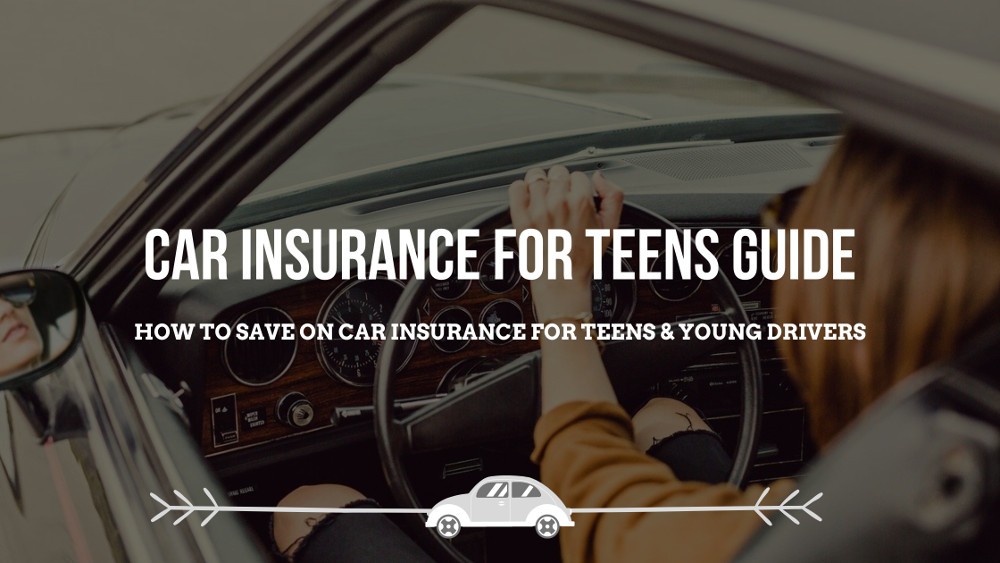
Insuring teens can quickly get expensive for parents. Insurance companies view young drivers - especially those under the age of 21 - as “high risk,” meaning that they are much more likely to make a claim. For this reason, keeping premiums low for people in this age group can be a significant challenge.
Fortunately, parents have some options for reducing the price, such as getting discounts and comparing quotes, which we discuss in greater detail below.
Why does insurance cost more for younger drivers?
There are five main reasons why insurance costs more for younger drivers.
1. Unproven records
In principle, there is no reason why a teen driver shouldn’t be able to drive a vehicle safely and cautiously. In fact, some might argue that their youth should help the matter. Being young means faster response times and greater capacity to see hazards.
In practice, though, things are different. While young drivers have a biological advantage over their older peers, their behavior isn't as consistent. As a group, they are much more likely to crash than any other.
Facts like these feed into the quotes that insurance companies issue. Because insurers don’t know anything about the young person's specific characteristics, they can’t differentiate them from their peers. And that is what pushes the price of their premiums up. Safe teen drivers get lumped in with everyone else in their age group, many of whom are taking significant risks on the road, and they wind up paying the price.
2. Less experience
Passing a driving test doesn’t guarantee experience. You can tick all the boxes, so to speak, and still be relatively unprepared for the real task of driving.
Experienced drivers have an intuitive feel for what they should do in certain situations. If somebody cuts them up on a roundabout, for instance, they know that the best thing to do is pull back. Likewise, if it is a rainy day, they understand that they need to leave more distance between themselves and the car in front in case they decide to slam on the brakes. These arise from years of observing other road users and predicting what they might do next.
Data from the Research Institute at the Children’s Hospital of Philadelphia suggests inexperience is a factor behind 75 percent of all accidents involving teens. Common errors include speeding excessively, becoming distracted by features on the road, and failing to scan for hazards.
3. More likely to engage in distracted driving
Teens are also more likely to become distracted while behind the wheel. Common issues include chatting to passengers, fiddling with the dashboard, or focusing on something outside of the vehicle.
The CDC reports that around nine people die, and 1,000 people get injured every day because of crashes involving distracted driving. Teens are responsible for this disproportionately, pushing up their premiums.
4. More likely to be reckless
Teens are also much more likely to engage in reckless driving behaviors, such as undertaking, speeding, or jumping red stop signs - something caused by the structure of their brains. Young drivers are far more likely to do dangerous things on the road because they haven’t yet built the adult mental apparatus necessary for rationally appraising risks. They don’t have a good sense of how dangerous their behavior on the road is. Again, this propensity for recklessness pushes up their premiums.
5. More likely to be in an accident
You might think that charging young drivers more for insurance is a kind of prejudice by insurance companies. But when you look at the statistics, you soon see that’s not the case. Like it or not, it is a brute fact that teens are much more likely to get into crashes than other age groups, and that explains their higher premiums.
Insurance companies have to tread a kind of tightrope. On the one hand, they need to keep premiums low enough to be competitive and affordable. But on the other, they need to cover the risks that young drivers pose.
And herein lies the problem. Crashes are much more likely to involve young drivers. So excess premiums can hit thousands of dollars per year.
Young drivers pose a serious threat to the financial stability of the insurance industry. Even though premiums are high, many insurers offer insurance for teens expecting a loss. They do this so that they can retain their business. At some point in the future, they will become safer drivers, allowing insurers to turn a profit.
How much does it cost?

So, given the above discussion, what can you expect to pay if you add a teen to your policy?
First, we should point out that every state is different in this regard. Where you live heavily influences the amount by which your premiums will rise.
Second, you should note that the car you drive will also affect the percentage premium you pay above your regular bills. The faster and more luxurious it is, the more you’ll have to spend when adding a teen driver.
Third, the cost of premiums also depends on the age of the teenager in question. 16-year-olds are the least experienced and have the shortest track record, so they typically pay the most. 19-year-olds have more driving hours under their belts as a group and so pay less.
Here are some stats:
The average 16-year-old driver increases the cost of a car insurance policy by between 130 and 140 percent - or approximately $2,000.
For 19-year-old drivers, that figure drops to $1,800 - still a lot more than the original premium, but not quite as much as for the 16-year-old case.
Let’s take a look at the kinds of percentage increases you can expect state-by-state:
| Alabama - 169% |
| Arizona - 219% |
| California - 217% |
| Colorado - 144% |
| Kansas - 134% |
| Kentucky - 142% |
| Maine - 124% |
| New Hampshire - 195% |
| New York - 176% |
| Pennsylvania - 118% |
| Texas - 167% |
Please note that insurance premiums can also vary wildly depending on the sex of your child. Male teenagers command much higher premiums than females.
Data suggest that the cost of a six-month premium for a 16-year-old male driver can top $3,897 versus around $3,378 for a female - a difference of $519 per year.
A 17-year-old male will pay around $3,366 on average, compared to a female who will cost $2,904 - a difference of $462.
For 18-year-olds, premiums fall again, but the gap between males and females remains. Males pay an average of $3,070, while females pay $2,631 - a difference of $439.
Finally, 19-year-old males see their premiums fall to $2409 - but that is still $365 more than females of the same age.
Overall, the average male teen driver pays around 14 percent more than the average female driver. This figure falls to just 8 percent for male drivers between the ages of 20 and 24.
Cheapest car insurance for teenagers
While you can occasionally set up a standalone policy for your teenager, the cheapest way to insure them is to add them to your existing car insurance. Even so, you’re still likely to pay a high price (as demonstrated by the figures reported above).
When it comes to adding a teenager to your existing insurance, state laws vary. In some jurisdictions, you have to add all license holders in your household to your policy. Failing to do so could mean that the insurer won’t cover you or anyone else you live with in the event of an accident.
Other states allow you to exclude teens from your policy and set them up on separate products, but examples of this are rare. Most require teens and parents to share the same cover.
Some states allow you to add teens to your insurance policy who do not yet have full licenses. These include North Carolina, Ohio, Virginia, West Virginia, New York, and Illinois - but these are by no means the norm.
And some states allow teens to own a car title in their name, but again, these are rare. Most mandate that parents add teenagers to existing policies.
Even if states don’t have age restrictions on who can own a policy in their own right, insurers often do. Thus, even if you live in a highly liberalized state, you usually can’t get policies for drivers under the age of 18. Your only option is to add them to yours if you want them to drive legally on the road.
In some cases, though, it makes financial sense to put teens on their own policy. For instance, if your teen is desperate for financial independence (perhaps because they’ve started their career early), looking for independent policies is a good option. Similarly, if your teen has a luxury car, then it may also make sense to insure them separately. This way, you avoid increasing your personal insurance costs substantially.
There are several other methods you can use to save on car insurance for teens.
-
Learner’s permit insurance.
-
Telling your insurance company that your teen has a learner’s permit can often save you money versus simply attaching a teen driver to the vehicle.
-
No coverage savings options.
-
Some insurance companies allow you to opt out of cover your teen, sometimes calling the feature a “named exclusion.” This method is a great way to cut your premiums, but it also means that the policy doesn’t cover your teen if they get into an accident. This option is excellent for parents who want to keep teens off their policies, but whether you can do it varies from state to state.
Car insurance discounts for teenagers
Car insurance companies offer a range of discounts for teenagers, based on a wide variety of factors. Getting them, however, requires some proactivity on your part. Most insurers won’t offer them upfront.
College discounts
College students can sometimes save using “resident student discounts” or “student away discounts.” The idea here is simple: if the student leaves the car at home (and lives more than 100 miles away from the vehicle’s registered address), then they’re probably not using it. This allows insurers to bring down the policy's price due to the reduced risk. Savings can sometimes top 30 percent or more.
Good driver discount
Insurers will offer money off your premiums if your teenager maintains a clean record and doesn't get involved in any accidents or violations.
Safe vehicle discount
Some insurers will also offer drivers of safer vehicles higher discounts. Certain features, such as seat belt reminders, can mitigate the risk of serious injury, reducing risks for insurers.
Low-mileage discount
Intuition tells you that the less your teen drives your car, the lower the risk they will get involved in an accident and need to make a claim. Therefore, several insurance companies allow you to fit telematics to your vehicle so that they can track how you drive, when you travel, and how far you go. Some give you a percentage discount based on your original premium, while others offer pay-as-you-go payment options where you only pay for the actual miles they travel.
Defensive driving discount
Defensive driving discounts work on a similar principle to low-mileage discounts. If you can prove to your insurance company that you’re a safe driver, they’ll use that information to lower your premiums compared to somebody with similar characteristics to you.
You can also do things like taking state-approved driver competence courses. Here you learn additional skills and techniques designed to reduce the likelihood of a collision, leading to discounts of between 10 and 15 percent.
Increase your deductible
Your deductible is the money you must pay the insurance company up front to make a claim. For most drivers, this payment is somewhere between $500 and $1,000. However, if you believe your teen is a safe driver and you have sufficient money in the bank to cover the deductible, you might want to go higher than this. Having a bigger deductible reduces the insurer's risk while increasing yours, encouraging them to lower their premiums.
Good student discount
Some insurance companies offer a “good student discount” to drivers with a grade point average of 3.0 or higher. The rationale is simple: harder working and more academically-inclined students are less likely to behave recklessly on the road. Discounts operate in the 5 to 10 percent range.
Adding a teenager to your policy

Adding a teenager to your policy is a relatively straightforward matter in most states, thanks to modern tools.
Step 1: Notify your existing provider
When your teen gets their full license, you’ll need to notify your existing provider immediately, updating them on the situation. Usually, you don’t have to commit to a policy renewal. Instead, you just inform them of the change in the status and then consider your options.
Step 2: Compare Quotes
The next step is to find competitive quotes through sites like InsureMojo. Your current insurer will usually offer you a decent rate, but there might be better options out there. Comparison sites make it easy to see how much you should be paying, given your particular circumstances.
Step 3: Consider the type of coverage you need
If your teen is about to head off to college and leave the car at home, it doesn’t make much sense to cover them for daily driving. Thus, it is critical to think carefully about your actual coverage requirements. You may only need a minimal amount of coverage for them or none at all.
Step 4: Stack discounts
In principle, there is no reason why insurance companies shouldn’t allow you to stack discounts. Unlike most offers, insurance discounts relate to the risk that a driver poses. So if your teen is both good at school and drives safely, then it makes sense to offer both discounts, one stacked on top of the other.
Please note that some insurance companies will be reluctant to do this. However, many will see the logic and use it as a tool to gain your business. These are the insurers you want.
Step 5: Talk about safety with your teen
While most teens are perfectly capable of driving a car, their ability to do so safely remains an issue. Many young people will take unnecessary risks while behind the wheel, increasing the likelihood of an accident.
As a parent, talking to your teen about safe driving is one of the best things that you can do to keep them on the straight and narrow. Have a chat with them about why it’s important to drive defensively and speak with them about their concern. Where possible, get them to internalize the desire to drive safely when you’re not there. Don’t try to force it on them as that can backfire.
Step 6: Use a safe car
While teenagers would love to drive sports cars, they are not the safest vehicles in the world. Teens need vehicles that behave predictably and forgivingly that don’t risk getting out of control when they depress the throttle. Cars should be moderately-powered and offer plenty of safety features and equipment to minimize the risk of injury.
